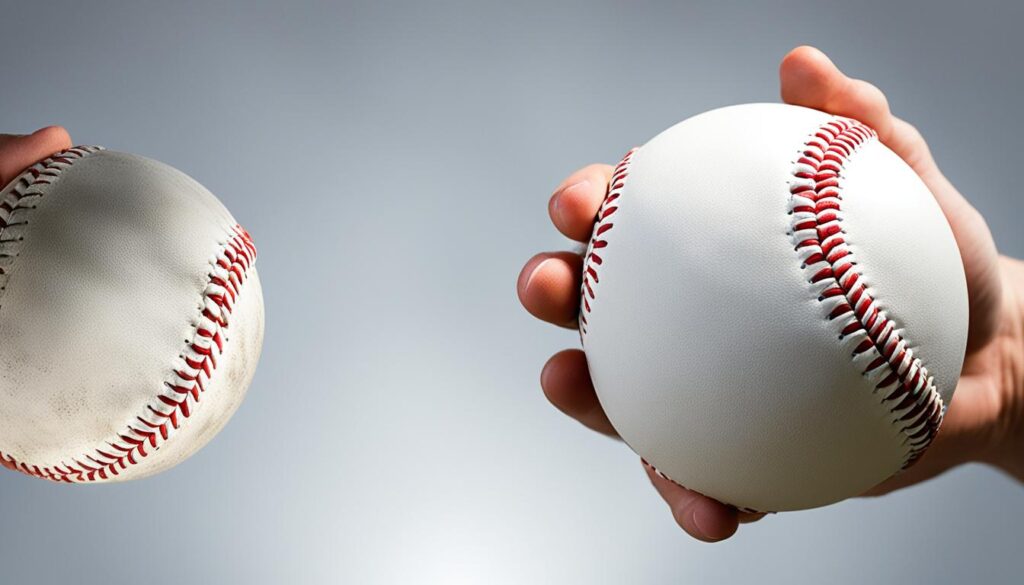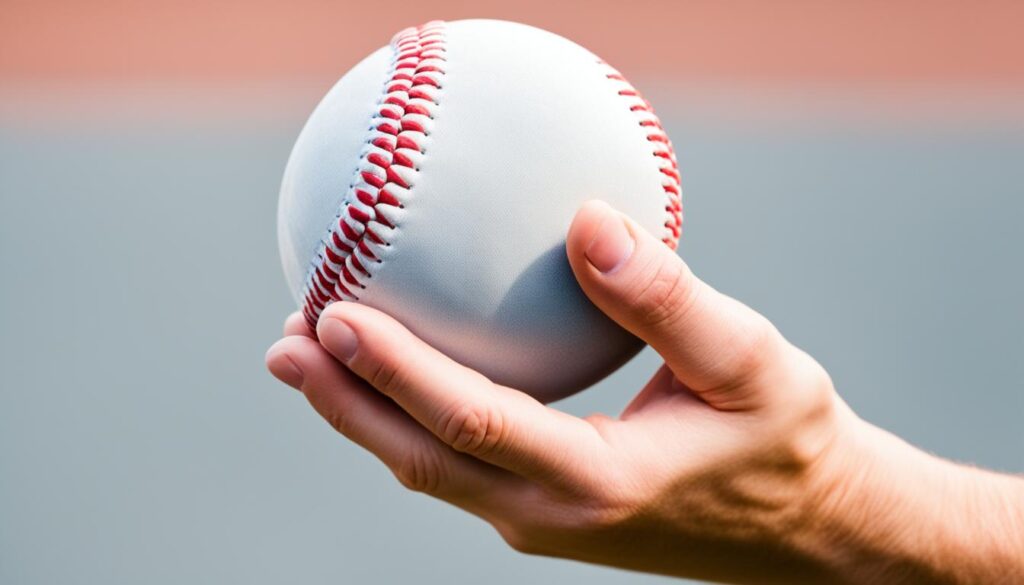
Imagine standing tall on the mound, the weight of the baseball in your hand, the crisp smell of freshly cut grass filling the air. You take a deep breath, feeling the excitement and nerves intertwine within you. As you wind up and prepare to unleash your pitch, everything else fades away. In that moment, it’s just you and the ball, focused on perfecting your technique and delivering a powerful fastball.
Baseball pitching is an art that requires skill, precision, and an unwavering commitment to mastering the fundamentals. And one key element that can elevate your game to the next level is the four-seam grip. This grip, often referred to as the fastball grip, is a foundation for pitchers who aspire to throw with great velocity and control.
With the four-seam grip, you have the power to harness the ball’s full potential, unleashing a pitch that leaves batters in awe and your teammates cheering in admiration. But how do you perfect this grip? What are the mechanics behind it? And how can you apply it to your own pitching style?
In this article, we’ll delve into the intricacies of the four-seam grip, exploring its technique, benefits, and tips for mastering this essential pitch. Whether you’re a seasoned pitcher looking to refine your skills or a budding talent eager to learn, this guide will equip you with the knowledge and insights you need to take your pitching to new heights.
Key Takeaways:
- The four-seam grip is a fundamental technique for enhancing fastball velocity and control in baseball pitching.
- Mastering the four-seam grip requires understanding its mechanics and practicing proper techniques.
- The four-seam fastball is a powerful pitch that can be used strategically to get ahead of hitters.
- Additional tips and adjustments can help pitchers maximize the effectiveness of the four-seam grip.
- Regular practice and experimentation with grip variations are essential for pitchers to develop their unique style and excel on the mound.
Introduction to Pitching Grips
Before delving into the specifics of the four-seam grip, it is important to have a basic understanding of pitching grips. Pitching grips refer to the different ways a pitcher holds the baseball to achieve desired ball movement and speed. A solid grasp of pitching grips is crucial for pitchers to effectively execute various pitches, including the four-seam fastball.
There are several different types of pitching grips used in baseball, each serving a unique purpose and offering different advantages for pitchers. These grips allow pitchers to manipulate the spin, trajectory, and movement of the ball, making it difficult for batters to anticipate and hit the pitch.
One of the most common pitching grips is the fastball grip, which is used to throw fastballs at high velocities. The fastball grip emphasizes power and speed, making it an essential skill for pitchers aiming to overpower hitters with their throws.
Other popular pitching grips include the curveball grip, slider grip, changeup grip, and knuckleball grip. Each grip requires subtle variations in finger placement, hand positioning, and pressure, resulting in distinct ball movement and velocity.
The Importance of Pitching Grips
Pitching grips play a vital role in the effectiveness and success of a pitcher’s repertoire. Mastering different pitching grips allows pitchers to keep hitters off-balance, disrupt their timing, and induce weak contact or swings and misses.
Furthermore, a thorough understanding of pitching grips enables pitchers to exploit the weaknesses of opposing batters by strategically selecting and executing specific pitches. This ability to vary pitch types and locations keeps hitters guessing and can lead to more favorable outcomes for the pitching team.
Additionally, pitchers who can effectively command and execute a wide range of pitches are often highly sought after in baseball. They possess the versatility to adapt to different game situations, exploit specific hitter tendencies, and contribute significantly to their team’s success.
| Pitching Grip | Description |
|---|---|
| Four-Seam Fastball Grip | The most common grip used for throwing fastballs. It emphasizes velocity and minimal ball movement, delivering a straight and powerful pitch. |
| Curveball Grip | A grip that enables pitchers to generate a sharp, downward break on the ball. It requires a firm grip and a specific wrist and finger position to create the desired curve. |
| Slider Grip | A grip that produces lateral movement on the ball, causing it to slide or cut across the plate. Pitchers use different finger placements and pressure to control the depth and speed of the slider. |
| Changeup Grip | A grip used to throw a pitch that looks like a fastball but has reduced velocity. The changeup grip involves holding the ball deeper in the hand and utilizing a modified finger position. |
| Knuckleball Grip | A grip where the pitcher’s fingernails or knuckles come into contact with the ball, creating unpredictable movement and velocity. It requires minimal spin and relies on the ball’s chaotic flight path to deceive hitters. |
Understanding the nuances of these pitching grips and practicing their execution is essential for pitchers aiming to excel in baseball. By developing a varied repertoire of pitches, pitchers can keep opposing batters off balance and enhance their overall effectiveness on the mound.
The Four-Seam Fastball Grip
When it comes to harnessing maximum velocity and power in your fastball, the four-seam fastball grip is a fundamental technique in baseball pitching. This grip allows pitchers to achieve greater control, precision, and speed in their throws.
The four-seam fastball grip involves placing your index and middle fingers perpendicular across one of the U-shaped seams of the baseball. The thumb should be positioned on the bottom part of the ball, splitting it in half between the index and middle fingers.
By adopting this grip, pitchers can generate optimal backspin rotation on the ball, resulting in a straight and powerful fastball. The proper alignment of the fingers on the seams allows for maximum control and enhanced ball movement, making it more challenging for batters to anticipate and make solid contact.
As pitchers develop their skills, it is essential to refine their grip and familiarize themselves with the feel and release point of the ball. Consistent practice, along with paying attention to grip pressure and wrist movement, contributes to mastering the four-seam fastball.
Mastering the Four-Seam Fastball Grip:
- Place index and middle fingers perpendicular across one of the U-shaped seams of the baseball.
- Position the thumb on the bottom part of the ball, splitting it in half between the index and middle fingers.
- Focus on a firm grip, with the ball settled deeply into the palm.
- Maintain a loose wrist for a smooth release with maximum extension.
- Experiment with finger pressure to achieve desired spin and velocity.
The four-seam fastball grip serves as a foundation for various pitching techniques, allowing pitchers to achieve consistency and effectiveness in their repertoire of pitches.
| Grip | Advantages |
|---|---|
| Four-Seam Fastball |
|
| Two-Seam Fastball |
|
| Cutter |
|
| Slider |
|
| Changeup |
|
The Mechanics of the Four-Seam Fastball
When it comes to throwing a four-seam fastball, mastering the mechanics is essential for achieving optimal results. The key to a successful throw lies in the grip, wrist movement, and timing. Let’s take a closer look at the mechanics of this powerful pitch.
Grip
The grip for a four-seam fastball should be firm and secure. Position the baseball deep into the palm, ensuring a strong hold. The index and middle fingers should be placed perpendicular across one of the U-shaped seams of the baseball, while the thumb rests on the bottom part of the ball, splitting it in half between the index and middle fingers. This grip allows for maximum control and power.
Wrist Movement
A loose wrist is vital for a smooth release with maximum extension. As you begin the throwing motion, focus on keeping your wrist relaxed, allowing for natural movement. Avoid tensing up, as it can hinder the delivery and result in a less effective pitch.
Timing and Release
The four-seam fastball is often employed early in the count to get ahead of hitters. However, experienced batters can time the pitch relatively easily. Therefore, mastering deception and maintaining consistency in your delivery are crucial. Focus on fluid mechanics and execute a consistent release point to keep batters off balance.
With consistent practice and attention to detail, you can refine your mechanics and unleash a powerful four-seam fastball. Keep in mind that each pitcher may have slight variations in techniques, so it’s important to find what works best for you.
“The mechanics of the four-seam fastball lay the foundation for a powerful and accurate pitch that can be a game-changer for any pitcher.” – [Pitching Coach Name]

| Benefits of Proper Mechanics for Four-Seam Fastball | Challenges of Improper Mechanics for Four-Seam Fastball |
|---|---|
| Increased velocity and power | Loss of control and accuracy |
| Improved ball movement and spin rate | Heightened risk of injury |
| Greater consistency in pitch delivery | Reduced effectiveness in fooling batters |
- Practice proper grip and wrist movement
- Focus on timing and consistency in release
- Work with a pitching coach for personalized guidance
- Video analysis can help identify areas for improvement
- Regularly perform strength and flexibility exercises to support pitching mechanics
Tips and Tricks for Throwing the Four-Seam Fastball
Perfecting your four-seam fastball grip is just the beginning. To truly excel in throwing this pitch, pitchers can follow several key tips and tricks to enhance their performance on the mound.
1. Practice Proper Wrist Movement
When throwing the four-seam fastball, it’s important to focus on the movement of your wrist. Improper wrist movement can affect the accuracy and velocity of your pitch. Practice a smooth and controlled wrist snap at the release point to generate maximum power and control.
2. Apply More Pressure with the Index Finger
The grip of the four-seam fastball allows pitchers to have more control over the ball’s spin. By applying more pressure with the index finger on the top seam, pitchers can increase the backspin on the ball, leading to greater movement and deceptive speed.
3. Maintain an Outward Arm Angle
As you deliver the four-seam fastball, maintain an outward arm angle to achieve a proper release point. This angle helps generate a straight trajectory and prevents the ball from tailing off or sliding across the plate, making it more difficult for the hitter to make solid contact.
4. Understand the Hitter’s Perspective
When throwing the four-seam fastball, it’s important to consider the hitter’s perspective. Study the tendencies and weaknesses of opposing hitters to strategically place your pitches. By identifying their preferences and exploiting their weaknesses, you can increase the effectiveness of your four-seam fastball.
5. Utilize Strategic Pitch Placement
Paying attention to pitch placement is crucial when throwing the four-seam fastball. Aim for specific areas of the strike zone that are difficult for hitters to square up on, such as high and tight or low and away. Mixing up locations will keep hitters off balance and maximize the effectiveness of the pitch.

| Tips and Tricks for Throwing the Four-Seam Fastball |
|---|
| 1. Practice Proper Wrist Movement |
| 2. Apply More Pressure with the Index Finger |
| 3. Maintain an Outward Arm Angle |
| 4. Understand the Hitter’s Perspective |
| 5. Utilize Strategic Pitch Placement |
Variations and Adjustments for the Four-Seam Fastball
While mastering the basic four-seam fastball grip is essential for pitchers, they can also make variations and adjustments to create different movement profiles and keep the batters guessing. Here are some techniques to explore:
Inward or Outward Tilt
By tilting the wrist slightly inward or outward while gripping the ball, pitchers can change the trajectory and movement of their four-seam fastball. An inward tilt can generate more sinking action, while an outward tilt can create a cutting or tailing effect.
Adjusting Fingertip Pressure
Changing the pressure applied to the fingertips can alter the spin and flight of the pitch. Increasing the pressure on the index finger can create more backspin, resulting in a rising fastball, while adjusting the pressure on the middle finger can produce sinking movement.
Experimenting with Thumb Position
The position of the thumb on the ball can influence its flight. Moving the thumb slightly towards the inner side of the ball can induce more movement, such as a cut fastball. Conversely, positioning the thumb towards the outer side can promote a straighter pitch.
Exploring Different Depths of Grip
Varying the depth at which the pitcher’s fingers grip the ball can change the release point and the amount of pressure applied. Gripping the ball deeper into the fingers can lead to a later release and increased velocity. Conversely, holding the ball more towards the fingertips can create better control and movement.
It is important for pitchers to experiment with these variations and adjustments to find what works best for them. Each pitcher’s comfort, pitching style, and desired pitch profile will determine which techniques are most effective. Regular practice and analysis of the results will help pitchers refine their grips and maximize the effectiveness of their four-seam fastball.
Variations and Adjustments for the Four-Seam Fastball
| Variation/Adjustment | Movement |
|---|---|
| Inward or Outward Tilt | Changes trajectory and movement; induces sinking or cutting/tailing action. |
| Adjusting Fingertip Pressure | Altars spin and flight; creates rising or sinking movement. |
| Experimenting with Thumb Position | Affects ball flight; induces cut fastball or straighter pitch. |
| Exploring Different Depths of Grip | Changes release point and pressure; influences velocity and control. |
Conclusion
Mastery of the four-seam grip is paramount for baseball pitchers looking to elevate their fastball and overall pitching technique. By understanding the mechanics, tips, and variations of the four-seam fastball, pitchers can significantly enhance their throws in terms of precision and velocity. Regular practice and experimentation with grip variations are essential for pitchers to develop their own unique style and excel on the mound.
By using the four-seam grip, pitchers can achieve maximum control and generate increased speed due to the optimal finger placement on the seams. This grip offers a straight and powerful trajectory, making it a go-to pitch for many professional pitchers. However, it is important to regularly refine and adapt the grip to suit individual preferences and play to a pitcher’s strengths.
Ultimately, the four-seam grip is an indispensable tool in a pitcher’s arsenal. Through continuous practice and dedication, pitchers can master this technique and elevate their performance on the field. Whether it’s enhancing accuracy, increasing speed, or outsmarting batters, the four-seam grip is a fundamental aspect of successful baseball pitching.
Recommended
- FROM THE DIAMOND: THE PSYCHOLOGY BEHIND CATCHERS’ THIRD BASE THROWS
- ELEVATE YOUR GAME WITH EXPERT BASEBALL TIPS

Meet Daniel Anderson, the heart and soul behind Baseball Pro Picks. At 49, Daniel’s life has revolved around baseball, a passion that’s as strong today as it was when he first fell in love with the game. Living in the USA, Daniel has dedicated countless hours to watching, analyzing, and understanding every pitch, hit, and home run, making almost no game missed. His deep-rooted love for the sport is matched only by his commitment to sharing insightful, expert analysis with fellow baseball enthusiasts. With decades of experience and a keen eye for the game’s nuances, Daniel brings a unique perspective that enriches Baseball Pro Picks. Trust Daniel to guide you through the intricacies of baseball with the authority and trustworthiness of a true aficionado.












